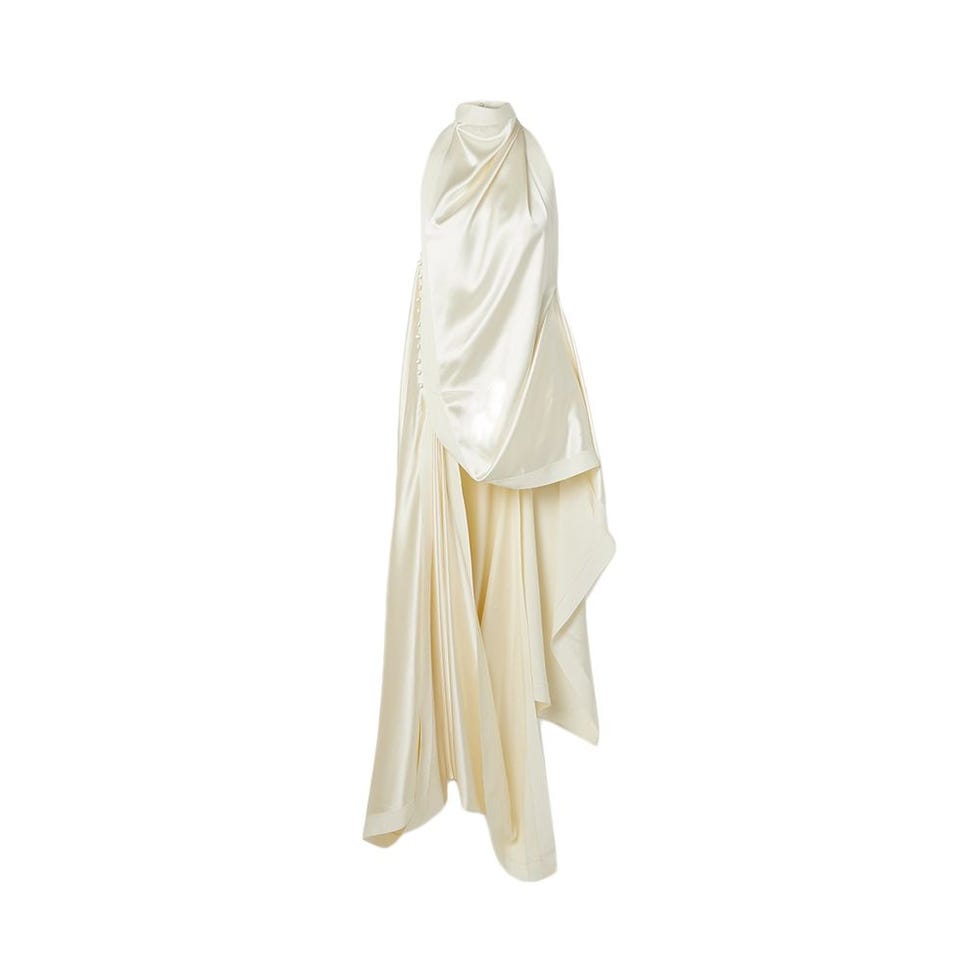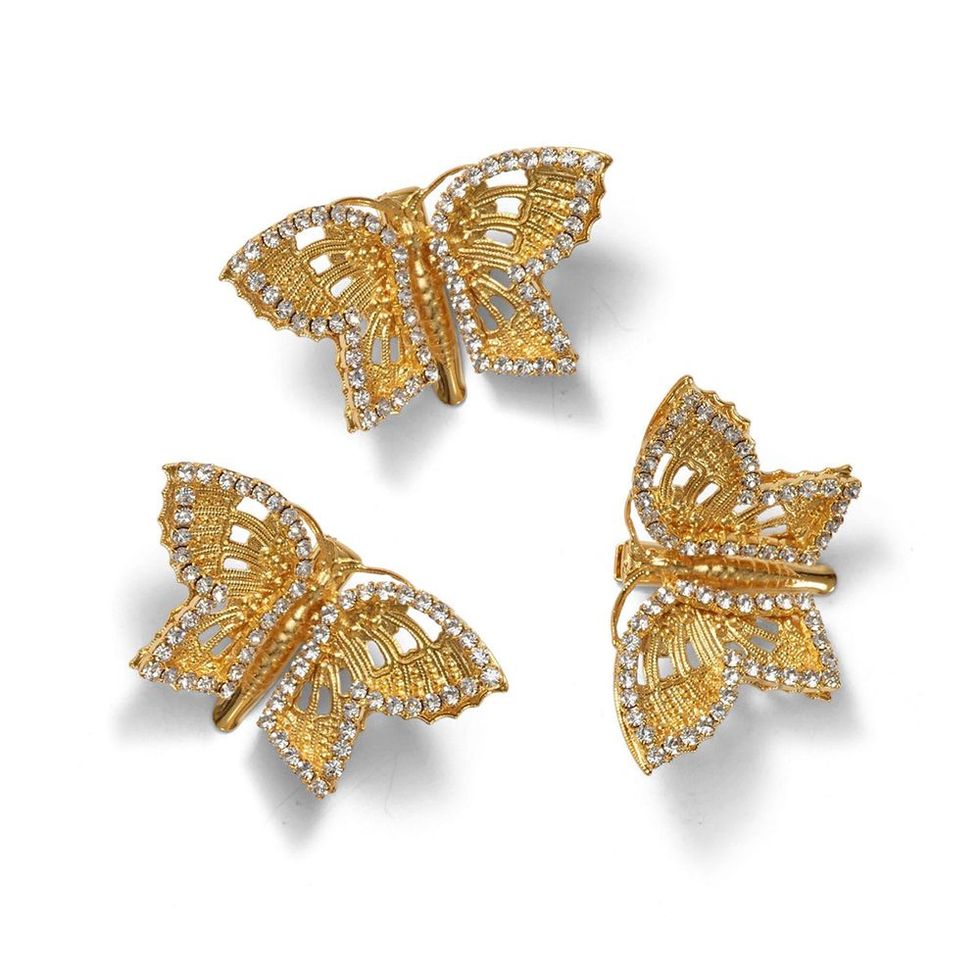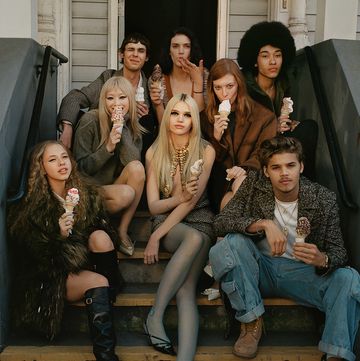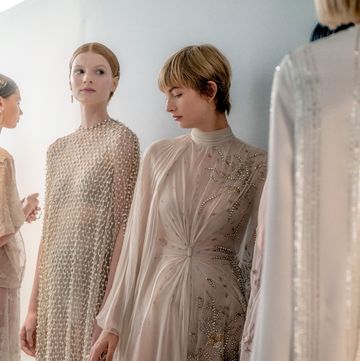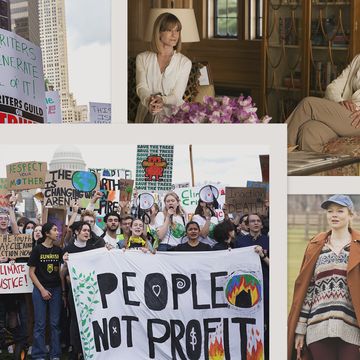Bridalwear has its mainstays: Big ball gowns, long trains, lacy veils. But within my group of girlfriends in their late-20s, the common thread is that mainstays no longer guarantee you to be the main event. Naked wedding dresses are trending. White pantsuits are in. Bridal bikinis are a thing. Call it a post-pandemic renaissance or the rise of neo-traditional trends. However you look at it, long-held beliefs about weddings and what marriages should be are evolving. With it, the bridal industry is changing into a more inclusive, eco-conscious, and creative community than ever before.
As a 2024 bride, my own search for “the dress” is like the best treasure hunt ever. The last couple months have been a swirl of studio appointments, calls with local designers, and hours scrolling through The RealReal—all in the name of tracking down something unexpected, made by someone who understands what I’m going for. The good news is that there is no dearth of extraordinary new talent in a market that, until now, has been notoriously sluggish to change.
New York City bridal designer Danielle Frankel’s eponymous label picked up buzz a few years back when Zoë Kravitz wore a crochet pearl cocktail dress to her rehearsal dinner. Since then, Frankel has garnered a reputation as an industry “disrupter.” But she’s just one designer in a crop of emerging fashion-girl favorites to buck bridal tradition. In fact, we’ve officially entered the anti-bride era, a burgeoning cycle of sartorial creativity where craftsmanship reigns king. This is about as far from Say Yes to the Dress as it gets. The anti-bride era is fresh, couture, and, above all, cool. Not a word generally associated with wedding attire. The shift, Frankel says, “is exciting.” Here’s where brides-to-be are flocking to for the big-day.
Danielle Frankel
It started with a glue gun and a tablecloth. “The first skirt I ever made,” Frankel recalls fondly. The wedding dress designer grew up with a grandmother who sewed, and an artsy mother. Both encouraged her preternatural creativity, even if that meant sacrificing an occasional kitchen linen in the name of fashion. After graduating from Parsons, Frankel honed her design skills on the Vera Wang bridal team. “Once I understood [the industry], it allowed me to feel a certain way about bridal,” Frankel says. “I felt there was room for opportunity and newness.” She started out designing gowns for friends, and then friends of friends. It was a “real educational journey,” Frankel says, “because I was talking to these brides about what they felt was missing [in the industry] that they had to come to me.” The focus-group all agreed it was hard to source simple, modern gowns that were, above all, expertly crafted.
Frankel retired her glue gun, recruited some of the most talented hands in New York to join her atelier, and launched her first collection. With distinctive details like bubble-skirting, crinkly-pleats, and organza capes, her work garnered an immediate cult following. “Our garments, they’re not overly feminine or overly masculine,” Frankel says. “They have components of both, which is why people gravitate to them. No one wants to be fully on one side… or at least my customers don’t.” Since then, Frankel has become the go-to for celebrity brides, including Alexandra Daddario, Julia Garner, AnnaSophia Robb, and Kate Bock. In November 2022, she dressed Naomi Biden for her historic White House rehearsal dinner; Biden styled her custom Frankel pantsuit look two ways: with a cropped blazer and veil, and with an asymmetrical cape.
Walking into Frankel’s New York City studio is like stepping into bridal heaven. Clients are greeted by racks of dresses in the slinkiest of silks and dreamiest of tulles. Frankel’s fabrics are all sourced from France, Italy, or Japan—and custom gowns are all sewn in-house. “We are molding garments onto bodies here,” she explains, “and to do that properly, we have to make them in the atelier.” She recently debuted a new collection, and plans to design more in the near future. “When a client comes to our studio, we want her to experience our world and surprise her,” Frankel says. “More is in store in the coming months.” Frankel is dressing A-listers, but she makes everyone who visits her feels like a VIP.
Independent, powerful, cool.
Shop the look
Sophie et Voilà
Some of the world’s best fashion comes from Spain. It makes sense, then, that Spain has also become an international destination for brides-to-be. Along the northern coast, in a town called Bilbao, is a design-duo shaking up the industry. Sofía Arribas and Saioa Goitia are the genius minds behind Sophie et Voilà, the go-to bridal wear company for European brides since 2016. Now, Sophie et Voilà is making waves stateside. Arribas, the brand’s creative director, draws inspiration from both ancient and contemporary Spanish culture, which she incorporates into each piece she designs. “Beautiful things,” she says, “those that were beautiful long ago or those that are beautiful now, like architecture, painting, sculpture, music.”
Arribas focuses on the fashion, while Goitia oversees the day-to-day operations at Sophie et Voilà. The brand’s entire team is actually made up of women who work in the Bilbao salon, where each bridal piece is designed, managed, and manufactured—all to avoid the transportation of unnecessary and polluted materials. To Arribas and Goitia, sustainability is not just a concept, but a core ethos of their company—as is quality, community, and innovation. “We try to stay away from trends,” says Arribas. “I follow the style and philosophy of the brand, and adapt that to each context, so it is difficult to coincide with other brands when designing. We are very proud to have built a firm with a recognizable style.”
Arribas likes to say her work channels Stephane Rolland’s brutalist minimalism, the delicacy of details by Giambattista Valli, and the effortless class of Jil Sander. “I try to maintain the balance of what is pure art and what I understand fashion should be,” she explains. “I draw whenever an idea comes to mind, [then] I collect all those drawings and end up selecting and adapting them organically.” The result is bridal magic. Sophie et Voilà is an archetype for the contemporary bride, with simple silhouettes and voluminous ornaments. At Barcelona bridal fashion week, Sophie et Voilà debuted a new collection that was uniquely sculptural, incorporating equal amounts of whimsy and refinement—an ethereal aesthetic that is a direct reflection of their customer. Or as Arribas describes her brides: “Independent women with style and personality.”
Chic, minimalist, refined.
Shop the look
Gigi Burris
Gigi Burris abides by a sartorial code: Traditional, but “with an irreverent twist,” says the milliner. “Romantic, graceful, and effortless.” Burris has hit the sweet spot with a line of contemporary-meets-classic bridal head pieces that are all manufactured by hand in New York using the ancient technique of hand blocking. Think: fedoras with silk organza flora, plume headbands, soft layers of French veiling, and oversize silk moire bows. “I believe that women are discovering new explorations of what it means to be a bride,” Burris says. “That thoughtful touch of something around the face gives acknowledgment to the special occasion, and a traditional cathedral veil is no longer the signifier.”
As bridal fashion continues to evolve, there’s something special about incorporating traditional millinery. Burris creates headbands, birdcage veils, and, of course, hats. Her best-seller is the Laura, a milk-ivory felt wide cuffed cap meant to mimic the shape of a flattering halo, which she calls “the supreme solution for a chic courthouse wedding, or a polished statement that stands out with any tailored bridal outfit.”
“[My clients] appreciate craft, sustainability, and a distinct style,” says Burris, who personally meets with the majority of brides who come through her atelier. “The attention to detail, quality, and personalized treatment creates a very emotional experience for an individual.” She adds: “We are truly honored to play a small part in such a special day, and the headpiece is often one of the most exciting aspects of the bridal outfit.” The Gigi Burris label frequently collaborates with other designers. Most recently, Burris developed what she calls a “unique creative friendship” with Alexandra O’Neill, the founder of Markarian. “We collaborate for private bridal clients,” Burris says. “In her most recent bridal collection release, we developed special something blue embroidered veilings, sky-blue tulle blushers, and crystal studded French blue violettes.” Whether it’s something new or something blue, brides can’t get enough Gigi Burris.
Traditional, delicate, daring.
Shop the look
Andrew Kwon
Andrew Kwon watched a lot of TV growing up. “One day there was a commercial with a tall, beautiful blonde woman running out of a red carpet event as Clair de Lune played,” he says. It was Nicole Kidman’s iconic Chanel No. 5 ad from 2004. “There was just something so magical and cinematic about it,” Kwon says. “I wanted to be a part of something like that one day.” It took a lot of hard work, but Kwon’s glittering dreams finally came true. His evening wear and bridal collections feature big bows, sparkling floral elements, and cotton candy-colored tulle. “The colors are inspired by memories and trips,” Kwon says, “so a lot of the colors I saw when I was in France—the green hills and the blue seas, that’s where a lot of those colors came from.”
When asked to describe his design aesthetic, Kwon laughs. “It just gives Andrew Kwon energy,” he says. The way his garments move certainly give off energy—but they also emote an almost angelic quality. That, of course, is intentional. “I’m trying to bring the fantasy and dream of the red carpet to a modern reality,” he says. “All my collections are inspired by mythology and Greek goddesses and zodiac and astrology.”
Kwon says he has been getting more and more requests for second and third wedding-day looks. “You get your statement piece for a walk down the aisle, but you also have your statement pieces for your rehearsal, reception, after-party, and luncheon looks,” he explains. “Girls are fighting for ways to incorporate more fashion into their wedding, other than just their walk down the aisle.” The Andrew Kwon bride is definitely a bride who wants to be seen. “A bride who wants to be that new fashion it-girl,” Kwon says. A bride ready for her Nicole Kidman moment in the spotlight.
Modern, glamorous, vibrant.
Andrew Kwon is available through in-person appointments at his atelier in New York City, which can be scheduled by emailing info@andrewkwon.com, as well as through traveling trunk shows starting this fall.
Lelet
There’s a reason brides love Lelet. “Hair wear comes from crowns, which relay a sense of power to the people around you,” the brand’s founder Sara Bieler Sasson explains. “There’s something to be said for wearing a head piece… when you feel good about yourself, you feel empowered, and I love being able to make women feel empowered.” Bieler Sasson started out in architecture, but left the corporate world after a couple years. While shopping for hair bows for her daughter, she realized her true passion. “I went to Michaels, bought some ribbon, and decided that I was going to make my own little hair accessory things, like this was what I was going to do [as my job] now,” she says. “I went door-to-door to little mom-and-pop shops and was like, ‘Do you want to buy this?’’ She got a lot of “nos.” Her first “yes” was at a pet store in Manhattan, where her bows were sold to puppy owners.
Fifteen years later, and Bieler Sasson’s dog days are far behind her. Celebrities like Anne Hathaway, Ariana Grande, and Taylor Swift have worn Lelet. Her pieces are also the must-have accessory for brides who “want to have a say in creating who they are walking down the aisle, and not necessarily just pick off the shelf what the bridal world is feeding them,” says Bieler Sasson. “I loved the idea of doing something a little more bold, a little edgier, but that is also feminine and powerful. I really love bridging the gap.”
Bieler Sasson’s most popular pieces are her pearl crowns, glossy headbands, and combs—and the practical bonus to Lelet is that most everything can be repurposed. “You can totally put that pearl comb back in your hair when you’re going out at night with a little black dress and be totally normal,” Sasson says. “Everything is super well-made, with the intent that you can wear it once, you can wear it twice, you can wear it a million times and then give it to your daughter, or keep it around and get a ton of use out of it, as opposed to just this one time situation.” Lelet is the bridal accessory that keeps on giving.
Whimsical, charismatic, sparkling.
Shop the look
Wiederhoeft
At this point in Jackson Wiederhoeft’s career, they are “really trying to let go.” That means leaving space for designs that are more visceral, more reactionary. “I spend so much time considering, reconsidering, redesigning something, and it’s almost always the first sketch that’s the most creative, raw, and exciting,” says the designer. “I’m also focusing a lot of my point of view from a post-gender mindset. My work is very informed by the female form, but I’m excited to venture into decontextualized aspects of design, especially around bridal, which is so steeped in tradition.”
Since 2019, Wiederhoeft has been turning heads with their unusually alluring designs, like a fully-beaded gold dress with a corseted bodice and a draped neckline. Wiederhoeft recently debuted an identical piece in white, and it’s “already been a hit,” they say. “Whenever people put the dress on, it’s amazing to watch them in the mirror. They’re so happy and excited to see themselves transformed into a figure of superhero proportions.” Wiederhoeft believes now is the time to change the American bridal market. Every piece from their collection tell a story, like a dress covered in tattoo embroidery with motifs relating to Eurydice, the tragic character from Greek mythology. Eurydice’s story (which is the subject of Broadway’s hit musical Hadestown) involves deadly snakes and lots of poetic music. “I had a bride recently who burst into tears just looking at it, without even trying it on yet,” Wiederhoeft says. “There’s an emotional aspect to the pieces that jump out at you, and I’m so happy to see that clients are engaging with the really directional pieces.”
The Wiederhoeft celebrant (as Wiederhoeft calls clients) is the type of person who “gets dressed according to their own narrative,” they say. “Their closet consists of curated vintage, personal basics, and emotional designer pieces.” To wear a Wiederhoeft piece is to be bold. “This is the type of person who lives for fashion, the kind of person who views their own dressing as a key factor of their identity,” they say. “Gender does not define them, though femininity fascinates them. The clothes become vocabulary, a statement more powerful than words.” The Wiederhoeft celebrant, they add, “is a theater-kid grown up—they are seriously comical, and fearless.”
Bold, fearless, fun.
Shop the look
Rose is a Senior Editor at ELLE overseeing features and projects about women's issues. She is an accomplished and compassionate storyteller and editor who excels in obtaining exclusive interviews and unearthing compelling features.





